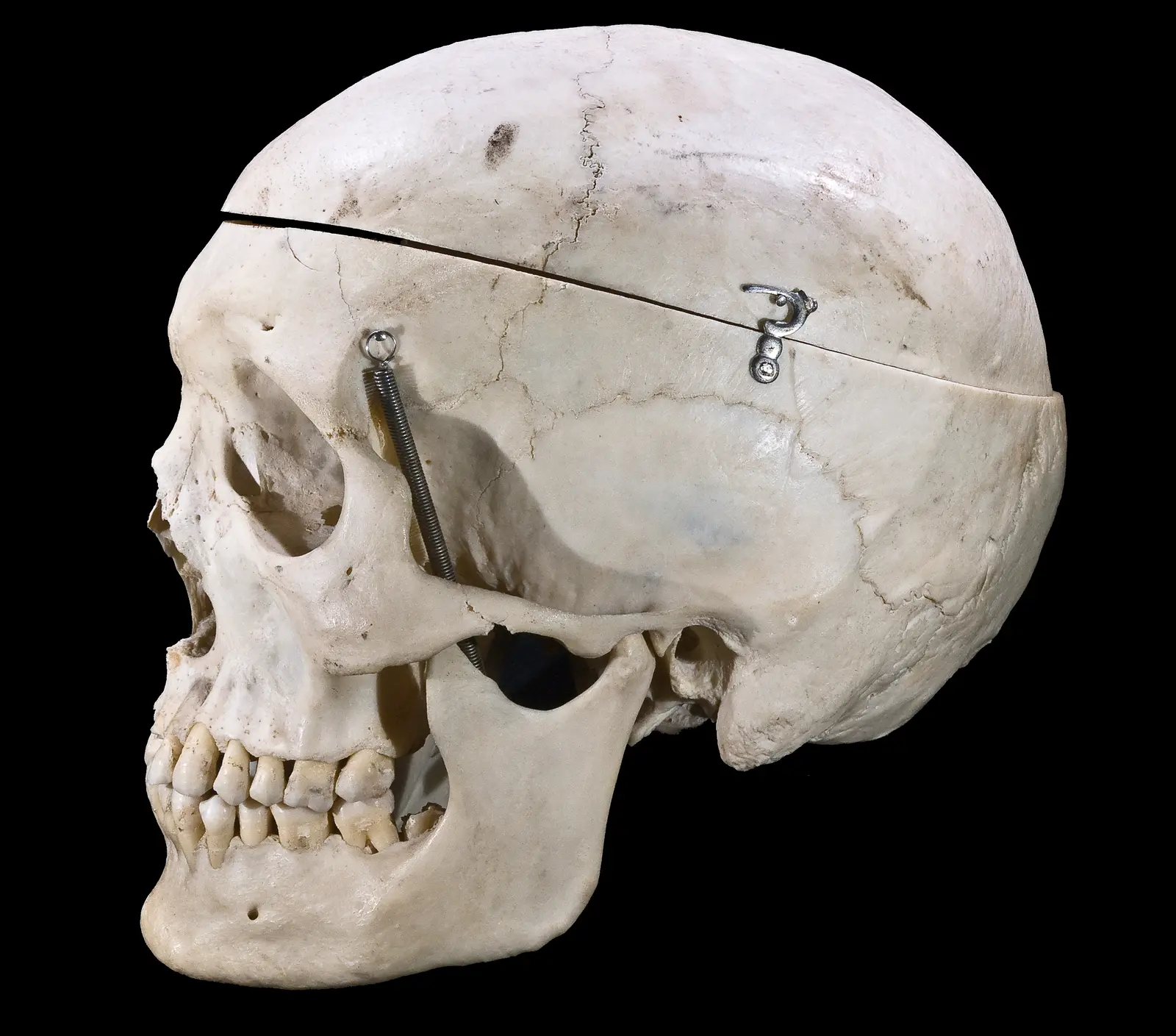TIL humans are the only animal with a chin. We aren't sure why.
TIL humans are the only animal with a chin. We aren't sure why.

It's an evolutionary conundrum, and scientists are still divided over the answer

TIL humans are the only animal with a chin. We aren't sure why.

It's an evolutionary conundrum, and scientists are still divided over the answer

Idk, I was assured that pigs had a chinny-chin-chin.
Growing up half Japanese I could never help laughing at that story as chinchin means penis in Japanese, and I think everyone should share in this amusement.
I will carry this sacred knowledge for the remainder of my fleeting time on this rock.
And giggle.
That's the exact lead in of the Atlantic article about this (paywall)
Have you seen humans without chins? That's why

Obviously its because of the lighting
My grandma said I was the most handsome boy... Are you calling my dead grandmother a liar?!
Yep


Truly superhuman.
TIL chins are only chins because they stick out. I had always considered the front of a lower jaw to be a "chin".
In other words some people really have no chin...

Peak humanity
The New Chad
Of course we know why. So that evolution could result in the universe's most perfect being.

Groovy

Of course we know why. So that evolution could result in the universe's most perfect
beingpatchwork.
If Chins Could Kill
This is why it bothers me when artists add chins to animalistic characters. It looks so wrong. An example:

Like, shit. Cool character design but you gave the cat lady a chin. Cats don't have chins, why did you give her a chin?
They don't have opposable thumbs, go into night clubs, walk bipedally or have those wing things either, why is it the chin that bothers you?
That character is mostly a cat skinned human.
Many animals, including most felids and canids, have a fifth toe (aka dew claw), which could potentially evolve into a thumb. You don't normally see it on domestic dogs though, because if I'm not mistaken, it usually gets cut off when they're a puppy due to it being weak and having a tendency to get caught on things.
Alternatively, there is polydactylism in cats, which can give them extra toes that can help them grab things (I've seen a video of a polydactyl cat using it's extra foretoe like a thumb, though I can't find it). It seems possible that, overtime, an extra foretoe like that might eventually provide enough of a evolutionary benefit for it to become a standard feature.
If cats evolved human-like intelligence, they'd absolutely have night clubs of some kind. That said, I'm not convinced that cats don't already have human-like intelligence and aren't just choosing to not use it, but that's beside the point.
Walking bipedally is something a lot of smaller mammals can do as well, it just isn't their normal mode of locomotion because their bodies aren't currently designed for it. Going the evolution route again, however, and it's possible that a species might eventually decide to stand up like humans did. Edit: I forgot about birds, dinosaurs and semi-bipedal mammals like the pangolin. Birds and pre-historic theropods walked on two legs, and pangolins have heavy tails they can use to balance on their hind legs so their forelegs are free to dig at ant mounds. So humans aren't the only animals that walk on two legs.
The wing things are part of her clothing.
You're correct that being bothered by a chin alone is strange, but,
A) people have weird things that bother them, sometimes illogically
B) I kinda look at anthropomorphic animals as being evolved from their real world counterparts, so I tend to rationalize things in regards to how they might have evolved. It makes it more believable for me.
C) iirc, in the context of the movie that specific character is from, thats actually someone's VR avatar. As such, it makes sense to make human concessions like opposable thumbs, five fingers and toes (cats technically have five toes on each forepaw, four toes on each hind paw), walking plantigrade, etc. A chin seems like an odd concession to make. From the article, it doesn't really give humans any really evolutionary advantage so it's not like you're gonna be unable to do something because you don't have a chin; and based on what I've seen in the furry community, chins on anthros doesn't really seem to have much of an aesthetic appeal either (otherwise nearly every fursona would have an obvious chin).
D) It just looks weird. Idk man, it just looks weird to me.
That said, I don't tend to mind hybrids or mythical creatures like gryphons, dragons, dragon-cats, or whatever, so idk. It just looks weird to me and I guess the thing about humans being the only ones with chins is a explanation and justification for why I find it weird-looking.
You're complaining about a chin on an anthropomorphic cat woman that only has 2 breast's instead of 6 to 8...
Based and put-more-titties-on-that-cat pilled
Why does it look like she has nipple piercings that couldn't be contained.
Thanks, new kink unlocked.
Isn't the point of this art to be an anthropomorphic cat? In that case, the chin is appropriate
except, as you can see, it makes them look terrifying, not like a cat.
you want khajiit, not Cats 2019
Burn it.
I see a chin on my cat?
You see a chin area yes, but it is simply the bottom of the jaw. The human chin has actual muscle that goes below the jaw bone and can be moved ever so slightly which aids in facial expression.
As bigfig said, your cat probably doesn't have a chin. That said, you might consider feeling your cat's chin to see if it's actually a chin and not just fluff or something.
If you feel a boney protrusion similar to a human's chin, then you should unironically contact an evolutionary researcher. They might be fascinated about your cat having an actual chin as humans and only humans (not even neanderthals) are the only known chin-havers. Who knows, your cat might be the "missing link" between chinned and chinless humanoids.
Call me shane dawson because I wanna put my dick near this cat.

I believe in not kink shaming, but that's just TMI
lmao
If I am not mistaken, according to the grammatical scrolls, having a chin makes everyone .. chinese
More chins than a Chinese phone book.
Boooooooo
(take my upvote)
I'll always upvote a Qi reference

Speaking of chins with bony protrusions
Believe it or not that picture was taken with the JWST in orbit. To fit her chin in frame.
Tell me about this chin.
If other animals don't have chins, they're using a weird definition of chin.
“If you're looking across all of the hominids, which is the family tree after the split with chimpanzees, there [are] not really that many traits that we can point to that we can say are exclusively human,” Duke University’s James Pampush tells Robert Siegel for NPR. “[T]hose animals all walked on two legs. The one thing that really sticks out is the chin.”
One of the most popular ideas is that our ancestors evolved chins to strengthen our lower jaws to withstand the stresses of chewing. But according to Pampush, the chin is in the wrong place to reinforce the jaw. As for helping us speak, he doubts that the tongue generates enough force to make this necessary. A third idea is that the chin could help people choose mates, but sexually selective features like this typically only develop in one gender, Pampush tells Siegel.
The spandrel hypothesis is as good a theory as any, but it too has its problems. It’s hard to find evidence to test if something is an evolutionary byproduct, especially if it doesn’t serve an obvious function. But if researchers one day do manage to figure out where the chin came from, it could put together another piece of the puzzle of what makes us different from our primate and Neanderthal cousins, Yong writes.
The dismissal of a sexually selected trait just because it usually is far more pronounced in one sex than the other seems extemely premature to me.
I would argue chins are actually already quite different between the sexes - to the point where people will have surgery to change their appearance if their chin doesn't conform to societal ideals.
Sexually selected trait seems like an avenue of research that shouldn't be so easily dismissed.
hard to find evidince
This is, like, an undergrad project.
I'm sure this has been done...
The one thing that really sticks out is the chin.
I see what you did there
I figure walking upright made being hit from below more common, necessitating thicker bones to protect the very sensitive nerves of the jaw.
Some humans even have double
The "spandrel hypothesis" is the front runner explanation. Essentially we didn't evolve to have chins but rather evolved other things that are helpful, and the chin is a byproduct of that other evolution. Not harmful so it didn't get selected away, but not helpful.
But chin is one of the points determining attractivity in males?
All of the the three little pigs had a chinny chin chin
Would you mate with somebody who didn't have a chin? Chins are sexy.
Why are chins sexy?
Same as boobs, Human female breasts are mainly sexual, they are too large for babies to feed.
they are too large for babies to feed.
Then it seems I must have seen some of them fake it really convincingly for some reason.
I'm sorry, but this isn't correct, adult human females have breasts to hide when they are in estrus, by always being swollen, it's called hidden estrose, it's a whole thing. This has a lot of data backing it up. I KNOW I'M SPELLING IT WRONG! PROOFREADING IS THE LAST RETREAT OF COWARDS!!!!
I'm Asian and this is not true for my breasts, tyvm
Useful in fighting as it helps protect the lower jaw and teeth?
But then again, it could simply be a trait we have developed over the millennia, and there is no deeper meaning to it.
I think this is plausible, also the fact that when you lean your head a little bit forward you expose the front of the skull which is the thickest part while the chin prevents people from punching your neck.
TIL LeafyIsHere isn't human after all...
But why did we evolve a hook & loop clasp to hold the top of our skull closed?
I hear some people are born with just a solid skull with no hinges, it makes me so uncomfortable.
It was a defense against the now extinct Brain Scooping Gorilla
To enable the Habsburg dynasty.
Yet again proving Chads are the pinnacle of evolution
Everything alive today is the pinnacle of evolution.
Nah, I'm of the view that evolution doesn't grow upwards, but sudeways. We are at the edge.
Duh it's where.our chin horn used to be...
I just read here this morning, that beards are for protection of the neck...
This was a good, short read. Worth the time.
I read somewhere sometime ago that the theory that makes the most sense is that we evolved chins to take a punch, which animals besides our immediate evolutionary relatives do not do.
So we evolved chins as an evolutionary advantage over our immediate evolutionary relatives who would logically be competing for the same resources.
I read something at some point about how our fists seemed to have evolved or at least adapted to be well suited to delivering a punch. Many people do not use proper hand forms for it, but I suppose it's a learned skill if not at least through trial and error.
Great, now I have a scenario in my head where one early human delivers a punch and dies of having not the right hands and the other dies because no chin. Also: Imagine our fists if there had been more habsburgs.
Mutual aid
The chin would act as a lever no? The longer the chin the harder your brain is shaken.
I'm a little shakey on the details but I think it has more to do with the extra bone mass in relation to the way the jaw functions. It acts more like a shock absorbing bumper than a lever.
Other animals that get punched there tend to take that blow more to the throat, which is a bit more problatic
I'm gonna guess the same reason we have big knuckles/fists and men have facial hair. Fighting.
How is facial hair beneficial in fighting?
It's neither beneficial nor an inherent detriment.
It doesn't provide enough padding to matter for anything, and the dangers of it bring grabbed are vastly exaggerated (been doing martial arts and grappling in one form or another since jr high, if you count a little wresting then, so over thirty years with breaks here and there, and bearded the entire adult time).
At best, blows will slide more and cut less, but not enough to really matter. At worst, having it grabbed hurts, which can be a bad distraction, but it isn't so sturdy as to not be easy to escape. It either pulls loose if their grip is bad, pulls out if their grip is good enough, or makes sure their hands are easy to reach, and allows you an easy access inside their reach.
Every little pro has a con, and vice versa, with none of it being a deciding factor.
A ponytail is worse, and a braid worse than that.
Besides, anyone with a beard that isn't just full mountain man is going to be oiling or otherwise treating their beard. This makes bare handed grips next to useless on them. And if you're in a full contact sparring session, you'll have other options to keep it from being a horrible thing.
Seriously. I have never once been tapped out because of my beard. I've never had any idiot during my years as a bouncer be successful in using it against me. Now, I have had to trim or shave it back because of having wads of it snatched out, but that's still a very minor issue compared to the other things that can happen in a fight.
If anything, the fact that people tend to have this weird reaction to a big, bearded guy compared to just a big guy, you get in less fights in my experience outside of training or a job. Going places with a full beard, even drunks wouldn't fuck with me the way they would other big guys. There's a bit of some kind of reaction where people think a beard = tough sometimes. No clue why, just that it's often enough to have noticed.
As in a signal of how manly a man truly is, comparative to still being a boy.
Edit: also, hair is counter productive in a fight, because it gives your opponent something to grab a hold of and use against you.
chin stab
It's slippery.
Chimps fight way worse than humans.
They fight differently, we like to punch.
You gotta throw fling your feces at them.
Yeah Chimps eat the losers
Aliens
What else would I stroke while thinking? 🤔
Well, you can't take it on the chin if you don't have one I suppose.
Otherwise we couldn't chin up.
So humans are also the only animal that can hear chin music?
Because of mewing. Every sigma knows this.
Huh, I figured it was to protect the throat since we don't have fur.
Except for Cowboy Cerrone. No chin on him at all heh.
It's for punching. 🤣
Artificial Intelligence Analysis:
The chin is situated near the area where the tongue and jawbone interact during speech. It's possible that the chin provides a surface for the tongue to move against, allowing for more complex sounds and articulations. The development of language is believed to have occurred around the same time as the emergence of Homo sapiens. While other primates have similar facial structures, they don't possess a distinct chin. This suggests that the chin might be related to the unique demands of human language.
Bingo -- other animals don't have a chin because they didn't invent languages like humans did for communication, and thus the demands of speaking weren't evenly distributed.
Next time on interesting questions 104: Why did homo sapiens develop language when other animals such as Corvids did not?
I do lick my chin a lot when articulating language. As we all do, right...? fellow humanoids ?
This makes more sense than the need to put on pillow cases (which has been my prevailing theory up to this point), but your question about corvids intrigues me. Partially because I'm not entirely certain of what a corvids is.
https://en.wikipedia.org/wiki/Corvidae
Corvids/Corvidae is a species of birds which include crows and ravens - they have demonstrated complex intelligence via tool use and social circles, so they're comparable to human intelligence of some specific various ages/milestones, but didn't invent a spoken language.